Huddersfield Town
Huddersfield is where Rugby League was created towards the end of the 19th century and it was not until 1907 that moves to form a professional association football club came to fruition. Having had their approach to share Huddersfield RFCs ground rebuffed, the founders bought a site on Leeds Road for £500. In September 1908 Huddersfield Town FC was launched and joined the North Eastern League. In their first game they wore white shirts but these were changed later to red and the team became known as the "Scarlet Runners." The following season they joined the Midland League in order to reduce traveling costs. A resolution passed in July 1909 is recorded as deciding on a playing strip of blue shirts with white knickers.
The club’s ambitious directors invited Archibald Leitch, the architect responsible for most of the larger stadia of the period, to design a ground capable of holding 34,000. Armed with these plans, the directors successfully applied to join the Football League, who were at that time actively promoting membership in the Rugby League heartlands of Yorkshire. They wore a distinctive white kit with a blue yolk.
The costs of the development proved too great a burden and, with gates of less than 7,000, Huddersfield went into liquidation in 1912. A new limited company was formed to take over the club’s assets but they fared little better. Gates fell to around 3,000 and by 1919 the club was £25,000 in debt.
Immediately after the First World War, the football establishment was shocked when Leeds City were ordered to disband for illegally paying players during wartime competition. A new club, Leeds United was immediately formed. Huddersfield’s chairman, J Hilton Crowther, announced in November 1919 that he planned to merge with the new outfit and move operations to Leeds where the public might be more supportive. The announcement roused the seemingly indifferent townspeople and, led by the local newspaper, there was an outcry. After weeks of frantic negotiations and fundraising, J Hilton Crowther was offered a financial settlement and he left to pursue his ambitions with Leeds United. The impact on the players was equally dramatic and at the end of the season they were beaten FA Cup finalists and won promotion to the First Division into the bargain. Huddersfield adopted their famous striped shirts after the war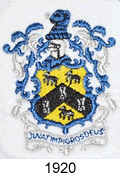 . Photographs suggest the blue was somewhat lighter than in modern times but this seems to be due to thye limitations of photography at the time, which tended to make blue appear paler than in reality.
. Photographs suggest the blue was somewhat lighter than in modern times but this seems to be due to thye limitations of photography at the time, which tended to make blue appear paler than in reality.
The first time a crest appeared on Huddersfield's shirts was in the 1920 FA Cup final when the towns coat of arms was worn. Although this did not appear in league games, it was worn in the team's several FA Cup final appearances over the next two decades.
Huddersfield Town now embarked on a period of incredible success, winning the FA Cup in 1922 and then an unprecedented hat-trick of League championships in 1924, 1925 and 1926. The following two seasons they were runners-up. The architect of their success was Herbert Chapman, the genius who, ironically, had been Leeds City’s manager at the time they were closed down. Chapman was joined Arsenal after Town’s second League title and he went on to repeat his extraordinary achievements there.
With crowds well in excess of 65,000 cramming themselves into Leeds Road, conditions on the terraces were primitive and after a series of near accidents that could have been fatal, the directors strengthened the barriers during the 1930s. While they could not recapture the achievements of the 1920s, Huddersfield remained a strong First Division outfit until the outbreak of the Second World War.
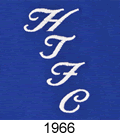 Immediately after the war, Huddersfield began to struggle. They spent one season in the Second Division (1952-53) but bounced back immediately. They were relegated again in 1956 and spent the next 14 seasons in the Second Division. During the mid 1960s manager Tom Johnston introduced plain blue shirts adorned with a monogramme crest, stripes having
Immediately after the war, Huddersfield began to struggle. They spent one season in the Second Division (1952-53) but bounced back immediately. They were relegated again in 1956 and spent the next 14 seasons in the Second Division. During the mid 1960s manager Tom Johnston introduced plain blue shirts adorned with a monogramme crest, stripes having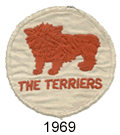 become unfashionable.
become unfashionable.
In 1969-70 the traditional shirts were restored and the club adopted the official nickname of "The Terriers" with a suitable badge to match. At the end of the season Town returned briefly to Division One. There followed a catastrophic decline and in 1975, they were in the Fourth Division. Scot Johnston returned to the club and reintroduced the plain blue shirts with monogramme associated with his previous spell at the club.
Meanwhile, the club’s enormous ground was becoming increasingly dilapidated. Capacity had been gradually reduced from 67,000 to 31,000 on safety grounds and would eventually be set at 14,000 after the Hillsborough disaster.
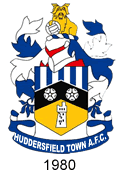 In 1980, Huddersfield won the Fourth Division title. The following season a new crest was introduced that combined elements of the old town coat of arms with modern motifs such as blue and white stripes and a terrier with a football. Three seasons later Huddersfield were promoted back to the Second Division. In 1988, they dropped down to what was now Barclay’s Division Two (the old Third Division). Seven years later they returned to the second level, now called Nationwide Division One.
In 1980, Huddersfield won the Fourth Division title. The following season a new crest was introduced that combined elements of the old town coat of arms with modern motifs such as blue and white stripes and a terrier with a football. Three seasons later Huddersfield were promoted back to the Second Division. In 1988, they dropped down to what was now Barclay’s Division Two (the old Third Division). Seven years later they returned to the second level, now called Nationwide Division One.
In 1992, planning permission was granted for a new stadium and, in a rather ironic twist, Huddersfield RLFC moved in to share the club’s Leeds Road ground, 85 years after they had snubbed the fledgling association club’s approaches. In May 1994 the two clubs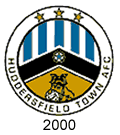 moved into the new McAlpine stadium and the following season, Town were promoted back to Nationwide Division One.
moved into the new McAlpine stadium and the following season, Town were promoted back to Nationwide Division One.
In 2000 a modern, circular crest was introduced but proved very unpopular with supporters not least because the team were relegated at the end of the season so this was soon dropped in favour of the previous design.
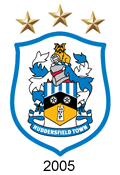 In 2002 the “Terriers” reached the play-offs the season after and then suffered relegation to the lowest division the year after that. Remarkably, the following season (2003-04) they were promoted and finished a creditable ninth in League One (the old Third Division) in 2005.
In 2002 the “Terriers” reached the play-offs the season after and then suffered relegation to the lowest division the year after that. Remarkably, the following season (2003-04) they were promoted and finished a creditable ninth in League One (the old Third Division) in 2005.
A modified crest was introduced for the 2005-06 season that placed the popular heraldic design inside a shield surmounted by three gold stars, representing the remarkable hat-trick of league wins won in the Twenties. The letters "AFC" were also dropped from the scroll underneath the crest.
